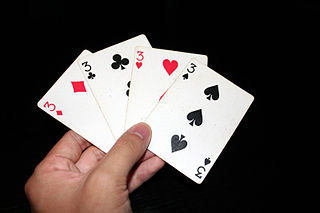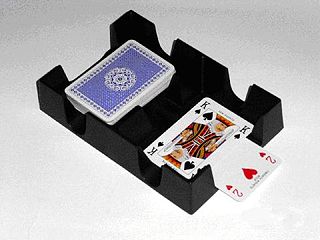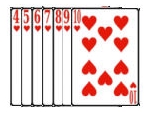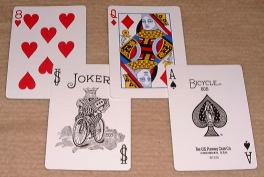
Gin rummy, or simply gin, is a two-player card game variant of rummy. It has enjoyed widespread popularity as both a social and a gambling game, especially during the mid twentieth century, and remains today one of the most widely-played two-player card games.

Canasta is a card game of the rummy family of games believed to be a variant of 500 Rum. Although many variations exist for two, three, five or six players, it is most commonly played by four in two partnerships with two standard decks of cards. Players attempt to make melds of seven cards of the same rank and "go out" by playing all cards in their hands. It is "the most recent card game to have achieved worldwide status as a classic".

500 rum, also called pinochle rummy, Michigan rummy, Persian rummy, rummy 500 or 500 rummy, is a popular variant of rummy. The game of canasta and several other games are believed to have developed from this popular form of rummy. The distinctive feature of 500 rum is that each player scores the value of the sets or cards they meld. It may be played by 2 to 8 players, but it is best for 3 to 5.
Spite and Malice, also known as Cat and Mouse or Screw Your Neighbor, is a traditional card game for two or more players. It is a reworking of the late 19th century Continental game Crapette and is a form of competitive solitaire, with a number of variations that can be played with two or three regular decks of cards. It is descended from Russian Bank.

Golf is a card game where players try to earn the lowest number of points over the course of nine deals.

Rummy is a group of matching-card games notable for similar gameplay based on matching cards of the same rank or sequence and same suit. The basic goal in any form of rummy is to build melds which can be either sets or runs. If a player discards a card, making a run in the discard pile, it may not be taken up without taking all cards below the top one.

Liverpool rummy is a multi-player, multi-round card game similar to other variants of rummy that adds features like buying and going out. It is played the same as Contract rummy, except that if a player manages to cut the exact number of cards required to deal the hand and leave a face-up card, then the cutting player's score is reduced by 50 points.
Yaniv, also known as Jhyap, Jafar or aa’niv, is a Nepalese card game popular in Israel. It is a draw and discard game in which players discard before drawing a new card and attempt to have the lowest value of cards in hand. The game is considered a backpackers game in Israel, and it's popular among soldiers and young adults returning from long backpacking trips.

Biriba is the Greek partnership version of a rummy card game of Italian origin called Pinnacola. The Greek name comes probably from the Italian game Biribara, or Biribisso, or Biribi, even if this game is totally different. It is played by two to six players, with two decks and 4 Jokers comprising 108 cards. If 6 players play, one more deck and two jokers more are added. Biriba can also be played by three players with or without partnership rules.

Rumino is a knock rummy card game of Italian origin played up to 6 players in which players try to form sets or sequences of cards. It may possibly have been devised in American during the 1940s by Italian immigrants by adapting the game Scala Quaranta to Gin rummy. It is usually played for small stakes Two 52-card decks are used plus four Jokers comprising 108 cards.
Three thirteen is a variation of the card game Rummy. It is an eleven-round game played with two or more players. It requires two decks of cards with the jokers removed. Like other Rummy games, once the hands are dealt, the remainder of the cards are placed face down on the table. The top card from the deck is flipped face up and put beside the deck to start the discard pile.

Continental Rummy is a progressive partnership Rummy card game related to Rumino. It is considered the forerunner of the whole family of rummy games using two packs of cards as one. Its name derives from the fact that it is played throughout the continental Europe, the United States, Mexico, Canada, and also in South America. According to Albert Morehead, it was "at one time the most popular form of Rummy in women's afternoon games, until in 1950 it lost out to Canasta."

Khanhoo or kanhu is a non-partnership Chinese card game of the draw-and-discard structure. It was first recorded during the late Ming dynasty as a multi-trick taking game, a type of game that may be as old as T'ienkiu, revised in its rules and published in an authorized edition by Emperor Kao Tsung in 1130 AD for the information of his subjects. Meaning "watch the pot", it is very possibly the ancestor of all rummy games.

Kalooki or Kaluki, is a version of Contract rummy popular in Jamaica, and it has become known as Jamaican Rummy. A version called "Super Kalooki" is played in tournaments, while a version called "Baby Kalooki" is often played with children or for purposes of teaching the game. There are a few variations of the game described in books and on the internet. A similar game is sometimes referred to as "Kalooki 40".

Ponytail Canasta is a variation of the card game Canasta. The rules for Canasta were standardized in North America around the 1950s and it was this version of the game that gained worldwide popularity. In many countries, classic Canasta is still played in more or less its original form, sometimes alongside a number of variations.
Buraco is a Rummy-type card game in the Canasta family for four players in fixed partnerships in which the aim is to lay down combinations in groups of cards of equal rank and suit sequences, there being a bonus for combinations of seven cards or more. Buraco is a variation of Canasta which allows both standard melds as well as sequences. It originated from Uruguay and Argentina in the mid-1940s, with apparent characteristics of simplicity and implications that are often unforeseeable and absolutely involving. Its name derives from the Portuguese word "buraco" which means “hole”, applied to the minus score of any of the two partnerships. The game is also popular in the Arab world, specifically in the Persian Gulf; where it is known as 'Baraziliya' (Brazilian). Another popular variation of Buraco is Italian.

The following is a glossary of terms used in card games. Besides the terms listed here, there are thousands of common and uncommon slang terms. Terms in this glossary should not be game-specific, but apply to a wide range of card games. For glossaries that relate primarily to one game or family of similar games, see Game-specific glossaries.

Cabo is a 2010 card game by Melissa Limes and Mandy Henning that involves memory and manipulation. The game uses a dedicated deck of cards with each suit numbered from 1 to 13, and certain numbers being marked as "Peek", "Spy" or "Swap". The objective of the game is for each player to minimize the sum of his or her cards, four of which are played face-down to the table at the start of a round. Face-down cards may be revealed and swapped by card effects.

German Rummy or Rommé is the most popular form of the worldwide game, Rummy, played in Austria and Germany. It is a game for 2 to 6 players and is played with two packs of French playing cards, each comprising 52 cards and 3 jokers. There are no partnerships. In Germany, the Germany Rummy Association is the umbrella organisation for local rummy clubs and organises national competitions. The game is often just known as Rommé in Germany and Rummy in Austria.

Treppenrommé is a card game for two to four players, which is a variant of Rummy played in Germany and Austria. The name means "Staircase Rummy" and comes from the fact that the discard pile must be arranged such that every card is partly covered and partly visible, forming a so-called 'staircase' (Treppe). The game appears to be closely related to 500 Rum, but there are several differences.











